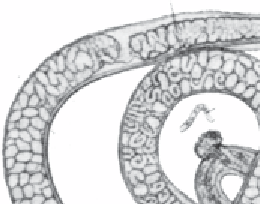Agriculture Reference
In-Depth Information
f
Table 9.4
Time/temperature combination for treatment of
domestic pig meat where core temperatures can be measured
g
Maximum core temp
of pig meat (°C)
Minimum consecutive time
period for the cold treatment
c
−18
106 hours
−21
82 hours
−23.5
63 hours
26
48 hours
29
35 hours
a
32
22 hours
35
8 hours
37
30 minutes
b
e
d
Figure 9.12
Adult female T. spiralis: (a) oral opening; (b) oesoph-
agus; (c) newborn larva, just expelled from vulva; (d) larvae in
interior portion of uterus; (e) fertilised and developing ova;
(f) ovary; and (g) rectum, ×100 (By courtesy of Dr. S.E. Gould).
temperature combination for cold treatment is depend-
ent on the thickness of the pieces of meat (see Table 9.3
for a summary). However, if it is possible to monitor the
core temperature of the pig meat, alternate time/tem-
perature combinations are allowed (Table 9.4).
4
Glanders
Where appropriate, solipeds are to be examined for
glanders. This requires careful inspection of the
mucous membranes from the trachea, larynx, nasal
cavities and sinuses and their ramifications. This
requires the head to be split lengthways.
Meat from horses found to have glanders is unfit for
human consumption.
5
Tuberculosis
Human infection with bovine TB from the consump-
tion of meat from infected cattle has never been
recorded. However, EU regulations require that animals
that have reacted positively to an intradermal tubercu-
lin test are slaughtered separately and that precautions
are taken to avoid cross-contamination. Where inspec-
tion reveals localised tuberculous lesions in more than
one organ or area of the carcase, the whole carcase and
its offals and blood should be declared unfit for human
consumption. If tuberculous lesions are found only in
a single organ or part of a carcase, the affected organ or
carcase area need only be removed.
The EFSA opinion on the public health hazards to be
covered by inspection of meat (bovine animals) (2013)
recognised that while there was no evidence that
M.
bovis
, bovine TB, could infect humans through meat in
the EU, traditional inspection through lymph node
incision provided important surveillance information,
particularly in low-incidence or officially tuberculosis-
free (OTF) member states or zones (Fig. 9.13).
6
Brucellosis
The carcase and offal from an animal with lesions
suggestive of acute brucellosis must be considered
unfit for human consumption.
Table 9.3
Summary of time/temperature combinations for
treatment of domestic pig meat for Trichinella
Cold
treatment
Maximum
thickness of
pieces of
pork (cm)
Maximum
temperature
of the chill
(°C)
Minimum
consecutive time
for cold treatment
(days)
1
Up to 15
−15
20
Up to 15
−23
10
Up to 15
−29
6
2
15-50
−15
30
15-50
−25
20
15-50
−29
12
3
Up to 25
−25
10
25-50
−25
20
Trichinella
testing of potentially infected swine and
equines is an official control within the EU, with the
specific technical detail of the testing regime laid down
in legislation, Regulation 2075/2005 and its successors.
Except for those few countries considered to be free from
Trichinella
, both in livestock and wildlife, samples must
be collected from breeding domestic pigs, that is, sows
and boars, wild boar, solipeds and pigs reared and fat-
tened outdoors, not in controlled housing. Examination
is either by direct observation of flattened striated muscle
samples through a stereoscopic microscope, a trichino-
scope, or through a bulk digest method, in which com-
pounded samples are treated with hydrochloric acid and
pepsin prior to microscopic examination.
Cold treatment of meat may be used as an alternative
to
Trichinella
testing for domestic pig meat. The time/



















